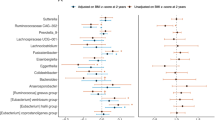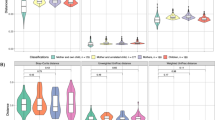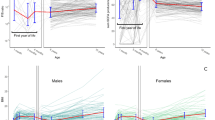Abstract
Background
The gut microbiota has been associated with overweight and obesity in adults, but the evidence in children is limited. Our aim was to study whether composition of the gut microbiota at the age of 3 years is associated with overweight/obesity in children cross-sectionally.
Methods
Children, who participated in a clinical trial of prenatal vitamin-D supplementation (VDAART), underwent standardized height and weight measurements, and collection of stool samples at 3 years of age. 16 S rRNA sequencing (V4 region) of the stool samples were performed with Illumina MiSeq. Associations between microbiota and overweight/obesity (body mass index z-scores >85th percentile) was analyzed using logistic regression.
Results
Out of 502 children, 146 (29%) were categorized as overweight/obese. Maternal pre-pregnancy BMI, birth weight and length, formula feeding during the first year, high frequency of fast food consumption, and time watching TV or computer screen at 3 years were the risk factors for overweight/obesity. Of the top 20 most abundant genera, high relative abundance of Parabacteroidetes (Bacteroidetes; Bacteroidales) (aOR(95% CI): 0.69 (0.53, 0.90, p = 0.007) per interquartile increase) and unassigned genus within Peptostreptococcae family were inversely associated with overweight/obesity, whereas high relative abundance of Dorea (Firmicutes;Clostridiales) (1.23 (1.05, 1.43, p = 0.009)) was positively associated. Associations were independent of each other. No associations were found between diversity indices and overweight/obesity.
Conclusions
Our data suggest that some of the differences in gut composition of bacteria between obese and non-obese adults can already be observed in 3-year old children. Longitudinal studies will be needed to determine long-term effects.
This is a preview of subscription content, access via your institution
Access options
Subscribe to this journal
Receive 12 print issues and online access
$259.00 per year
only $21.58 per issue
Buy this article
- Purchase on Springer Link
- Instant access to full article PDF
Prices may be subject to local taxes which are calculated during checkout

Similar content being viewed by others
References
Ng M, Fleming T, Robinson M, et al. Global, regional, and national prevalence of overweight and obesity in children and adults during 1980-2013: a systematic analysis for the Global Burden of Disease Study 2013. Lancet. 2014;384:766–81. https://doi.org/10.1016/S0140-6736(14)60460-8.
Umer A, Kelley GA, Cottrell LE, Giacobbi P,Jr, Innes KE, Lilly CL. Childhood obesity and adult cardiovascular disease risk factors: a systematic review with meta-analysis. BMC Public Health. 2017;17:683.
Morgen CS, Angquist L, Baker JL, Andersen AM, Michaelsen KF, Sorensen TIA. Prenatal risk factors influencing childhood BMI and overweight independent of birth weight and infancy BMI-a path analysis within the Danish National Birth Cohort. Int J Obes (Lond) 2017;42:594–602. https://doi.org/10.1038/ijo.2017.217.
Vos MB, Welsh J. Childhood obesity: update on predisposing factors and prevention strategies. Curr Gastroenterol Rep. 2010;12:280–7.
Mueller NT, Whyatt R, Hoepner L, Oberfield S, Dominguez-Bello MG, Widen EM et al. Prenatal exposure to antibiotics, cesarean section and risk of childhood obesity. Int J Obes. 2015;39:665–70. https://doi.org/10.1038/ijo.2014.180.
Francis L, Shodeinde L, Black MM, Allen J. Examining the obesogenic attributes of the family child care home environment: a literature review. J Obes. 2018;2018:3490651. https://doi.org/10.1155/2018/3490651.
Taverno Ross SE, Macia L, Documet PI, Escribano C, Kazemi Naderi T, Smith-Tapia I. Latino parents’ perceptions of physical activity and healthy eating: at the intersection of culture, family, and health. J Nutr Educ Behav. 2018;50:968–76.
Sanchez M, Panahi S, Tremblay A. Childhood obesity: a role for gut microbiota? Int J Environ Res Public Health. 2014;12:162–75.
Shore SA, Cho Y. Obesity and asthma: microbiome-metabolome interactions. Am J Respir Cell Mol Biol. 2016;54:609–17.
Sonnenburg JL, Backhed F. Diet-microbiota interactions as moderators of human metabolism. Nature. 2016;535:56–64.
Walters WA, Xu Z, Knight R. Meta-analyses of human gut microbes associated with obesity and IBD. FEBS Lett. 2014;588:4223–33.
Armougom F, Henry M, Vialettes B, Raccah D, Raoult D. Monitoring bacterial community of human gut microbiota reveals an increase in Lactobacillus in obese patients and Methanogens in anorexic patients. PLoS One. 2009;4:e7125.
Million M, Angelakis E, Maraninchi M, et al. Correlation between body mass index and gut concentrations of Lactobacillus reuteri, Bifidobacterium animalis, Methanobrevibacter smithii and Escherichia coli. Int J Obes. 2013;37:1460–6.
Turnbaugh PJ, Hamady M, Yatsunenko T, et al. A core gut microbiome in obese and lean twins. Nature. 2009;457:480–4.
Verdam FJ, Fuentes S, de Jonge C, et al. Human intestinal microbiota composition is associated with local and systemic inflammation in obesity. Obesity (Silver Spring). 2013;21:E607–15. https://doi.org/10.1002/oby.20466.
Santacruz A, Collado MC, Garcia-Valdes L, et al. Gut microbiota composition is associated with body weight, weight gain and biochemical parameters in pregnant women. Br J Nutr. 2010;104:83–92. https://doi.org/10.1017/S0007114510000176.
Ferrer M, Ruiz A, Lanza F, et al. Microbiota from the distal guts of lean and obese adolescents exhibit partial functional redundancy besides clear differences in community structure. Environ Microbiol. 2013;15:211–26.
Furet JP, Kong LC, Tap J, et al. Differential adaptation of human gut microbiota to bariatric surgery-induced weight loss: links with metabolic and low-grade inflammation markers. Diabetes. 2010;59:3049–57.
Schwiertz A, Taras D, Schafer K, Beijer S, Bos NA, Donus C, et al. and SCFA in lean and overweight healthy subjects. Obesity (Silver Spring). 2010;18:190–5.
Million M, Lagier JC, Yahav D, Paul M. Gut bacterial microbiota and obesity. Clin Microbiol Infect. 2013;19:305–13.
Mayorga Reyes L, Gonzalez Vazquez R, Cruz Arroyo SM, et al. Correlation between diet and gut bacteria in a population of young adults. Int J Food Sci Nutr. 2016;67:470–8.
Tims S, Derom C, Jonkers DM, et al. Microbiota conservation and BMI signatures in adult monozygotic twins. ISME J. 2013;7:707–17.
Patil DP, Dhotre DP, Chavan SG, et al. Molecular analysis of gut microbiota in obesity among Indian individuals. J Biosci. 2012;37:647–57.
Riva A, Borgo F, Lassandro C, Verduci E, Morace G, Borghi E, et al. Pediatric obesity is associated with an altered gut microbiota and discordant shifts in Firmicutes populations. Environ Microbiol. 2017;19:95–105.
Bervoets L, Van Hoorenbeeck K, Kortleven I. et al. Differences in gut microbiota composition between obese and lean children: a cross-sectional study. Gut Pathog. 2013;5:10.
Borgo F, Verduci E, Riva A, Lassandro C, Riva E, Morace G, et al. Relative abundance in bacterial and fungal gut microbes in obese children: a case control study. Child Obes. 2017;13:78–84. https://doi.org/10.1089/chi.2015.0194.
Hu HJ, Park SG, Jang HB, et al. Obesity alters the microbial community profile in Korean adolescents. PLoS One. 2015;10:e0134333.
Karlsson CL, Onnerfalt J, Xu J, Molin G, Ahrne S, Thorngren-Jerneck K. The microbiota of the gut in preschool children with normal and excessive body weight. Obesity (Silver Spring). 2012;20:2257–61.
Payne AN, Chassard C, Zimmermann M, Muller P, Stinca S, Lacroix C. The metabolic activity of gut microbiota in obese children is increased compared with normal-weight children and exhibits more exhaustive substrate utilization. Nutr Diabetes. 2011;1:e12.
Balamurugan R, George G, Kabeerdoss J, Hepsiba J, Chandragunasekaran AM, Ramakrishna BS. Quantitative differences in intestinal Faecalibacterium prausnitzii in obese Indian children. Br J Nutr. 2010;103:335–8.
Sordillo JE, Zhou Y, McGeachie MJ. et al. Factors influencing the infant gut microbiome at age 3-6 months: findings from the ethnically diverse Vitamin D Antenatal Asthma Reduction Trial (VDAART). J Allergy Clin Immunol. 2017;139:482–91.
Litonjua AA, Lange NE, Carey VJ, et al. The Vitamin D Antenatal Asthma Reduction Trial (VDAART): rationale, design, and methods of a randomized, controlled trial of vitamin D supplementation in pregnancy for the primary prevention of asthma and allergies in children. Contemp Clin Trials. 2014;38:37–50.
Litonjua AA, Carey VJ, Laranjo N, et al. Effect of prenatal supplementation with vitamin D on asthma or recurrent wheezing in offspring by age 3 years: the VDAART Randomized Clinical Trial. JAMA. 2016;315:362–70.
A SAS Program for the 2000 CDC Growth Charts (ages 0 to <20 years). Atlanta, GA. The Center for Disease Control and Prevention. October 27, 2016; Available at: https://www.cdc.gov/nccdphp/dnpao/growthcharts/resources/sas.htm. Accessed on 20 October 2016.
Langille MG, Zaneveld J, Caporaso JG, et al. Predictive functional profiling of microbial communities using 16S rRNA marker gene sequences. Nat Biotechnol. 2013;31:814–21. https://doi.org/10.1038/nbt.2676
Boulange CL, Neves AL, Chilloux J, Nicholson JK, Dumas ME. Impact of the gut microbiota on inflammation, obesity, and metabolic disease. Genome Med. 2016;8:42.
Barlow GM, Yu A, Mathur R. Role of the gut microbiome in obesity and diabetes mellitus. Nutr Clin Pract. 2015;30:787–97.
Braithwaite I, Stewart AW, Hancox RJ. et al. Fast-food consumption and body mass index in children and adolescents: an international cross-sectional study. BMJ Open. 2014;4:e005813.
Vinding RK, Sejersen TS, Chawes BL, Bonnelykke K, Buhl T, Bisgaard H, et al. Cesarean delivery and body mass index at 6 months and into childhood. Pediatrics 2017;139:e20164066.
Kasai C, Sugimoto K, Moritani I, et al. Comparison of the gut microbiota composition between obese and non-obese individuals in a Japanese population, as analyzed by terminal restriction fragment length polymorphism and next-generation sequencing. BMC Gastroenterol 2015; 15:100.
Forbes JD, Azad MB, Vehling L, et al. Association of exposure to formula in the hospital and subsequent infant feeding practices with gut microbiota and risk of overweight in the first year of life. JAMA Pediatr. 2018;172:e181161.
Villamil SI, Huerlimann R, Morianos C, Sarnyai Z, Maes GE. Adverse effect of early-life high-fat/high-carbohydrate (“Western”) diet on bacterial community in the distal bowel of mice. Nutr Res. 2018;50:25–36.
Hollister EB, Riehle K, Luna RA. et al. Structure and function of the healthy pre-adolescent pediatric gut microbiome. Microbiome. 2015;3:36.
Eckburg PB, Bik EM, Bernstein CN. et al. Diversity of the human intestinal microbial flora. Science. 2005;308:1635–1638.
Keane KN, Calton EK, Carlessi R, Hart PH, Newsholme P. The bioenergetics of inflammation: insights into obesity and type 2 diabetes. Eur J Clin Nutr. 2017;71:904–12. https://doi.org/10.1038/ejcn.2017.45.
Cani PD, Amar J, Iglesias MA, et al. Metabolic endotoxemia initiates obesity and insulin resistance. Diabetes. 2007;56:1761–72.
Lindberg AA, Weintraub A, Zahringer U, Rietschel ET. Structure-activity relationships in lipopolysaccharides of Bacteroides fragilis. Rev Infect Dis. 1990;12(Suppl 2):S133–41.
Paun A, Danska JS. Modulation of type 1 and type 2 diabetes risk by the intestinal microbiome. Pediatr Diabetes. 2016;17:469–77.
Acknowledgements
We thank families who have taken part of the VDAART study. We would like to thank Nancy Laranjo for data management; John Ziniti and Nicholas Wolfe for helping with the microbiota data and advanced statistical analyses; Pauli Tuoresmäki for helping with the figure. We also thank the project coordinator, study coordinators and research assistants at the VDAART clinical centers (at Washington University St. Louis, Boston University Medical Center and Kaiser Permanente Southern California). This study was supported by NIH grants HL091528, HL108818 and 1UL1TR001430, and the research grants from the Academy of Finland (grant 287675); the Juho Vainio Foundation; the Foundation for Pediatric Research; and by the National Institute for Health and Welfare, Finland.
Funding
AB has received research grants from the NIH. DRG was funded by NIH grant HL108818. STW and AAL were funded by NIH grant HL091528. The remaining authors (AMK, JES, LBB, GTOC and RSZ) have no financial relationships relevant to this article to disclose.
Author information
Authors and Affiliations
Contributions
Dr. Karvonen carried out the initial statistical analyses, interpreted data, drafted the initial manuscript, and reviewed and revised the manuscript; Dr. Sordillo designed sequencing assessment, interpreted data, and reviewed and revised the manuscript; Drs. Gold, Bacharier, O’Connor, Zeiger, and Beigelman acquired and interpreted data, revised manuscript critically for important intellectual content; Drs. Weiss, Litonjua, and Gold designed the study concept. Drs. Weiss and Litonjua coordinated and supervised data collection, interpreted data, revised manuscript critically for important intellectual content. All authors approved the final manuscript as submitted and agree to be accountable for all aspects of the work.
Corresponding author
Ethics declarations
Conflict of interest
The authors declare that they have no conflict of interest.
Additional information
Publisher’s note: Springer Nature remains neutral with regard to jurisdictional claims in published maps and institutional affiliations.
Supplementary information
Rights and permissions
About this article
Cite this article
Karvonen, A.M., Sordillo, J.E., Gold, D.R. et al. Gut microbiota and overweight in 3-year old children. Int J Obes 43, 713–723 (2019). https://doi.org/10.1038/s41366-018-0290-z
Received:
Revised:
Accepted:
Published:
Issue Date:
DOI: https://doi.org/10.1038/s41366-018-0290-z
This article is cited by
-
Characterization of gut microbiota associated with metabolic syndrome and type-2 diabetes mellitus in Mexican pediatric subjects
BMC Pediatrics (2023)
-
Gut microbiome transitions across generations in different ethnicities in an urban setting—the HELIUS study
Microbiome (2023)
-
Nine weeks of high-intensity indoor cycling training induced changes in the microbiota composition in non-athlete healthy male college students
Journal of the International Society of Sports Nutrition (2021)
-
Preliminary evidence for an influence of exposure to polycyclic aromatic hydrocarbons on the composition of the gut microbiota and neurodevelopment in three-year-old healthy children
BMC Pediatrics (2021)
-
NOD1 deficiency promotes an imbalance of thyroid hormones and microbiota homeostasis in mice fed high fat diet
Scientific Reports (2020)



